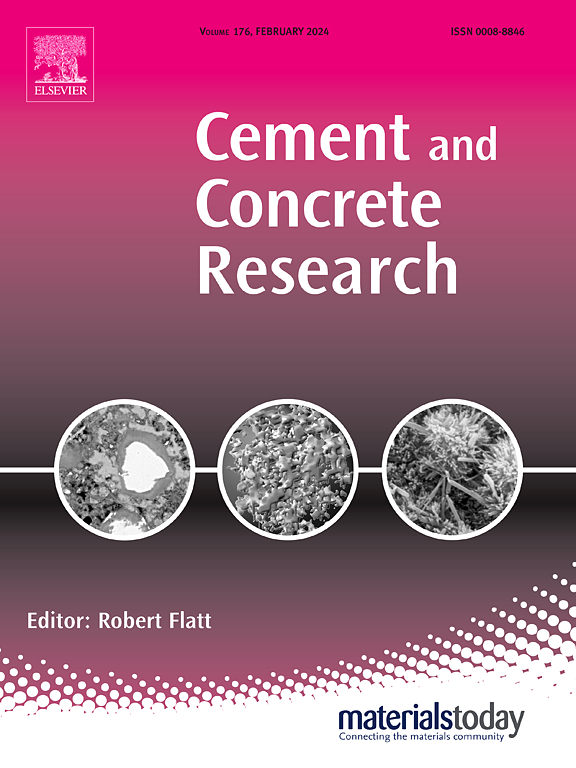Discrete element modeling on nanoindentation creep behavior of C-S-H under berkovich and flat-tip indenters
IF 10.9
1区 工程技术
Q1 CONSTRUCTION & BUILDING TECHNOLOGY
引用次数: 0
Abstract
This paper employs the discrete element method (DEM) to simulate the nanoindentation creep of calcium-silicate-hydrate (C-S-H), focusing on indentation deformation, particle interactions, and stress transmission paths. The Rate Process Theory (RPT), previously utilized in the creep modeling of cohesive soils and other granular materials, is proposed to simulate C-S-H creep. Due to the nanometer size of C-S-H particles, the critical time step in DEM simulations is very small. Therefore, a time-scaling algorithm is used to match the DEM simulation time with the physical time in laboratory tests, accelerating the simulation time by a factor of 1 × 108. C-S-H particle assemblies with specific packing densities are generated using Particle Flow Code (PFC3D, version 5.0), with coordination numbers and cohesion forces controlled by the stress-servo of PFC walls. Virtual nanoindentations using a Berkovich indenter are conducted on C-S-H particle assemblies with three different packing densities (0.74, 0.64, and 0.58), followed by parameters calibration. Results show that the DEM + RPT method can capture the scaling relations between the indentation modulus, hardness, and contact creep modulus of C-S-H particle assemblies and the packing density. Furthermore, DEM simulations reveal particle rearrangement under Berkovich and flat-tip indenters, highlighting that different indenter types lead to distinct creep kinetics in C-S-H, with the Berkovich indenters experimentally capturing long-term creep and flat-tip indenters measuring short-term creep.
C-S-H纳米压痕蠕变行为的离散元建模
本文采用离散元法(DEM)模拟了水合硅酸钙(C-S-H)纳米压痕蠕变过程,重点研究了压痕变形、颗粒相互作用和应力传递路径。采用速率过程理论(RPT)模拟黏性土和其他颗粒材料的蠕变。由于C-S-H颗粒的纳米尺寸,在DEM模拟中的临界时间步长非常小。因此,在实验室测试中,采用时间尺度算法将DEM模拟时间与物理时间进行匹配,使模拟时间加快1 × 108倍。采用颗粒流代码(PFC3D, 5.0版)生成具有特定堆积密度的C-S-H颗粒组合,配位数和内聚力由PFC壁的应力伺服控制。使用Berkovich压头对三种不同堆积密度(0.74、0.64和0.58)的C-S-H粒子组件进行虚拟纳米压痕,然后进行参数校准。结果表明,DEM + RPT方法可以捕捉到C-S-H颗粒组件的压痕模量、硬度和接触蠕变模量与堆积密度之间的标度关系。此外,DEM模拟揭示了Berkovich压头和平端压头下的颗粒重排,突出了不同类型的压头导致C-S-H中不同的蠕变动力学,Berkovich压头实验捕获长期蠕变,而平端压头测量短期蠕变。
本文章由计算机程序翻译,如有差异,请以英文原文为准。
求助全文
约1分钟内获得全文
求助全文
来源期刊

Cement and Concrete Research
工程技术-材料科学:综合
CiteScore
20.90
自引率
12.30%
发文量
318
审稿时长
53 days
期刊介绍:
Cement and Concrete Research is dedicated to publishing top-notch research on the materials science and engineering of cement, cement composites, mortars, concrete, and related materials incorporating cement or other mineral binders. The journal prioritizes reporting significant findings in research on the properties and performance of cementitious materials. It also covers novel experimental techniques, the latest analytical and modeling methods, examination and diagnosis of actual cement and concrete structures, and the exploration of potential improvements in materials.
 求助内容:
求助内容: 应助结果提醒方式:
应助结果提醒方式:


